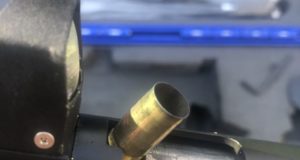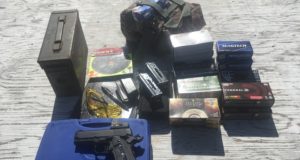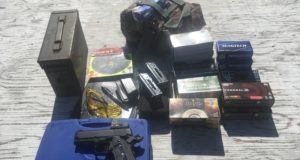After the NRA Annual Meeting wrapped in St. Louis last Sunday, I had another day of filming video and a day in transit getting back home, and I'm currently three days into a fun-filled seven day stretch of saving lives and stamping out disease on the ambulance, where people are calling 911 in the middle of a monsoon because they pooped themselves, or police officers would like us to pronounce a suspect whole and healthy and unimpaired from his Monadnock shampoo before spending the night in jail…
… I tell ya, this sleep deprivation thing ain't as easy as it was when I was 25, and being away from KatyBeth for 14 days straight has done nothing to improve my demeanor.
Still, while I have a rare couple of hours of breathing room, I figured I'd share with you some of the stuff that caught my interest at the NRA Annual Meeting:
The view from the room at The Millennium that Matt G. and I shared.
The people and the venue were very welcoming, and I enjoyed my week in St. Louis. I daresay I shall visit there again. The service and staff at The Millennium hotel were excellent. My only gripe is that the housing bureau NRA used to book rooms doesn't allow you to specify double or king. There is a small box where you can type in special requests, but apparently it is there only for decoration, because they assigned us a room with one king-sized bed. Still, Matt was surprisingly gentle for such a large man, and I even got to be the outside spoon on one of those nights. Other than our room having only two electrical outlets that worked, and those that did so worn out they would barely hold a plug, I have no complaints.
Brass Bullets
One of the first booths Matt and I encountered was the display for Cutting Edge Bullets. If you worship at the Church of the Light, Fast Bullet, then the folks at Cutting Edge preach your kind of gospel. They specialize in making lathe-turned solid copper or brass bullets from solid bar stock, milled to very exacting tolerances.
Eat hot lead brass!
Now, you might wonder, as I did, why a brass bullet over jacketed lead? A machined brass bullet will have a lighter weight than a jacketed lead bullet of identical length and shape, and comparable ballistic coefficient. That translates to a faster, flatter-shooting round that retains its velocity better at longer ranges, and environmentally friendly to boot.
Since brass bullets don't expand, Cutting Edge relies on fragmentation to produce secondary wound channels. Their hollow point of their ESP (Enhanced System Projectile) Raptor bullet is designed to fragment into six smaller fragments, creating secondary wound channels as the base of the bullet continues forward for maximum penetration.
The ESP Raptor, three bullets in one. Pictured with Talon ballistic tip inserted.
ESP Raptor hollow point with Talon tip
ESP Raptor, load it base-forward to punch very deep holes, no matter how much bone is in the way.
The ESP Raptor bullet is essentially three bullets in one. Load it into a case with hollow point out for the shrapnel effect, or insert the Talon plastic tip for hollow point bullet performance with a much higher ballistic coefficient. Load it base-first, and you have a solid, flat point brass bullet for maximum penetration.
My experience with solid brass or copper bullets is purely anecdotal, but positive. On Epic Hog Hunt 2010, Alan and TOTWTYTR were armed with AR15's, and jumped a herd of hogs on the last day. We never recovered the hog Alan shot with 55 gr FMJ lead bullets, but the one TOTWTYTR shot with my AR15 loaded with 62 gr copper Barnes TSX bullets went home in Matt G's ice chest. During skinning, the Barnes bullet shattered the near hip, transited the pelvis, broke the femur on the opposite side, and exited.
Cutting Edge advertises superlative accuracy and superior terminal performance, and their tests in ballistic gelatin looked impressive. However, the ultimate proof is when the metal meets the meat, so Matt and I will be getting a batch of these for T&E to handload and wring out at Blogorado and Epic Hog Hunt 2012.
Night Sights
Over at the Lone Wolf Distributors booth, where you can pretty much build your own Glock using zero Glock parts, we found Caleb showing off his sexy new Glock 21 slide, and giving impromptu lessons in defensive tactics (throw coffee, skedaddle). I coon-fingered their Timberwolf Glock 17 frame. The verdict: feels nice, very much like my 1911's.
But what I really dug was Lone Wolf's night sight display, which allowed you to try out various iterations of tritium and fiber optic sights in daylight and simulated night conditions. I've been looking for a pair of high visibility night sights for my 1911's and my Glock 17, and I think I found them:
Fiber optic sights, green rear / red front, in daylight.
Fiber optic sights, green rear / red front, at night.
In my opinion, these were the best of the bunch.
I tried out sights by Trijicon, Warren Tactical, Ameriglo, Meprolight and Glock OEM night sights, but in the end, the ones that appealed most to my tired old eyes were the Truglo Fiber Optic Bright Sites. I've used Truglo archery pins and shotgun beads and been well-satisfied with them, and I can't wait to try them on my handguns. CNC-machined out of steel, featuring a combination of tritium and fiber optic construction for excellent visibility in all light conditions… yeah, I think these will do just fine.
Mossberg's Modular Shotgun
I've long held the opinion that there are only two pump shotguns ever made worth mentioning: the Winchester Model 12, and the Remington 870. If you voted for Eisenhower and miss the days when station wagons still had real wood panels, you probably dig the Model 12, but as far as I'm concerned, the Remington 870 is the best pump shotgun ever made.
Having said that, I realize there are quite a few Mossberg 500 fans out there, and their new modular design makes it even more attractive. If you can only afford one gun for wingshooting, turkey hunting, deer hunting and home defense, the Mossberg Flex System might be just for you. Buy yourself a Model 500 or 590 receiver outfitted in whatever livery you prefer, and then get yourself to accessorizing, son! It's like Barbie, for gun nuts!
Mossberg Flex 500 pieces 'n parts
The stock, forend and recoil pad can be removed and replaced in seconds using Mossberg's TLS™ (Toolless Locking System). It's actually a pretty nifty setup. You can convert your camo duck hunting gun to a tacticool Evil Black Shotgun in mere seconds. Here's the Mossberg rep showing you how it works:
httpv://youtu.be/cNYqOajrsts
Ruger's New Offerings
One of the big hits of the show was Ruger's new takedown 10/.22. Jay G. obviously likes it:
Yes, he looks unhinged. It's Jay G. He looks that way even in his sleep.
Packaged in its own Ruger backpack (Hey Ruger, how about a waterproof, floating hard case?), this rifle is everything an AR7 ought to be and usually isn't. If the takedown version retains the practical accuracy and reliability of the standard 10/.22 platform, it should be a major hit. The barrel and fore end separate from the stock and receiver by means of depressing a small latch on the bottom side of the fore end, and rotating the barrel off its mount. The pieces cam together very solidly, and it seems like a pretty sweet setup.
httpv://youtu.be/Vnpp_16oPds
While we're talking about Ruger rifles, Matt G. and I got a chance to coon-finger the new Ruger American. This is not just another version of the Ruger 77. It's an entirely new rifle. Rather than use the proven Mauser-type action with twin lugs and an external extractor featured on the M77, the American features a three-lug bolt with a 70o throw. Gone also are the controlled-round feeding of the M77 and the three-position safety, in favor of a simple push-feed and the tang safety that Ruger dropped from the M77 line in 1991.
Ruger American bolt. Three locking lugs, 70o throw, internal extractor and plunger-type ejector.
The American features a free-floating barrel with the receiver bedded on steel v-blocks that are molded into the stock, and a detachable box magazine. It also sports a blade-type adjustable trigger reminiscent of the Savage AccuTrigger.
Ruger American with Ruger Marksman Adjustable™ trigger.
Ruger American with detachable, four-round rotary box magazine.
Ruger promises superior accuracy and reliability with the American, and at an MSRP of only $450 or so, it oughta make a dandy budget rifle. I know it looks good, but does it shoot good? Time will tell, I suppose. Who knows, maybe I can wrangle a T&E gun from Ruger to wring out at Blogorado in a few months.
Smith & Wesson M&P Shield
Everybody was gaga over the M&P Shield, and for good reason. The single-stack subcompact addition to the M&P line is aimed squarely at the Ruger LC9 / Taurus 709 / Kahr CW9 / Keltec PF9 market, and should compete admirably. The interchangeable grip panels of the M&P line were sacrificed for weight and size, I suppose, but the trigger on the M&P Shield is noticeably better than the full-sized versions of the M&P line. The pistol felt good in my hand, and I was able to wrap all my fingers around the grip of the 9mm version, even without the extended 8-round magazine. Caleb puts the M&P Shield through its paces here.
M&P Shield in .40 S&W with extended 7-round magazine.
Smith & Wesson M&P Shield 9 mm. 7+1 capacity, 19 ounces and just over an inch wide. An admirable balance between concealability and shootability..
Speaking of M&P stuff, I had a chance to try the Apex Tactical trigger kits for the Smith & Wesson M&P line, and I agree with all the other rave reviews. The weapon I tried had the duty carry kit with 5½ # trigger springs, RAM (Reset Assist Mechanism), hardened sear and striker block, and they Provide a significant improvement in an already decent trigger. Seriously, Smith & Wesson should just have their custom shop make M&P pistols with Apex Tactical triggers pre-installed. They're that good.
Stay tuned for blogroll updates and miscellaneous pics from the show…
 Ambulance Driver Files A Day in the Life | Kelly Grayson
Ambulance Driver Files A Day in the Life | Kelly Grayson

















